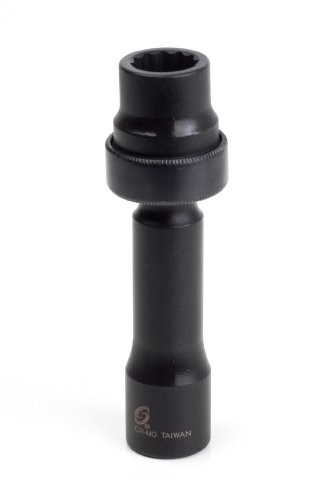is the timing light actually firing?
even if the balancer slipped it should read something unless the thing slipped 180 degrees and the light is firing on the balancer with no timing marks.
or did the marks sticker fall off?
lets assume worst case scenario, your balancer slipped and now you have no idea the timing, but the engine is running.
First disconnect and plug off the vacuum advance. you just want to run on mechanical advance.
now you can vacuum tune the engine.
Bring the idle screw down so the engine is just about to stall but running steady. The reason you do this when you set ignition timing is to make sure 100% that the mechanical advance is NOT coming on at all.
hook up your tach so you can see the rpms.
next install a Vacuum gauge on full manifold vacuum, NOT ported vacuum.
What you do now is Tune for Max vacuum reading.
Here is the tricky part. As you advance the timing the Rpms will go up and the Vacuum will go up. You have to keep adjusting the idle rpms to remain constant with the rpms you set when you first started. So if you started at 525rpms, then you must maintain that rpm as you adjust the distributor and watch the vacuum gauge for the highest reading.
Remember you advance the distributor and vacuum will go up, because rpm is going up, so always reset the rpms back down, so you can compare one reading to the next.
So lets say after you fart around with the distributor for 20 minutes you find your highest reading at 525rpms is like 14HG, now you back off the distributor 1-2 HG.
lock the distributor down. Reset Idle rpms to Spec, i find spec can be too low for some engines 650rpm is a good range.
Remember to set the idle rpms with the headlights on, and the car in gear with somebody inside on the brake, you have to set the idle rpms under transmission load and electrical load.
Ok now your ready for test #1.
shutdown the motor, wait 1-2 minutes, and try to start it again. This will test for a hot start problem, if the engine will not fire, then you will need to retard the distributor slightly. even though you just went through all that you will have to compensate for the ability of the starter to actually start the engine when its hot.
Now if you shutdown the engine, and she keeps on trying to run, that is called dieseling, that means you need to retard the timing slightly.
Test #2 go for a drive, with the vacuum advance still disconnected you will need to drive the car, look for a really huge long straight hill, and punch it up the hill.
you will need to listen for a notable change in the exhaust tone, if you hear marbles rolling around in a metal tube, back off the throttle and head for home your engine is pinging and you will need to retard timing slightly. keep going back and forth from the garage to the road until the pinging stops. if the car starts to hesitate that could be another problem with the fuel system. if advancing the timing makes the hesitation go away but the pinging starts then you have to start looking at the carburator for problems or the mechanical advance for problems.
if the pinging never stops that is a lean condition and you could have other problems with the ignition system.
ok so now your car isn't pinging, and its not hesitating. Time to hook up the vacuum advance. if you have a tunable vacuum advance great! if not don't worry yet.
go for a drive check for pinging. if you have none, and you have an adjustable vacuum advance then you can keep tuning in more and more vacuum advance timing until she pings then back off 1-2 turns. if you don't have a adjustable vacuum advance then you run what you broung.
So that is how you would set timing using a vacuum gauge.
if your balancer slipped then you will need somebody to fix it, because its involved, you have to take most of the stuff off the front of the engine, pull the rad fan and belts.
pull the valve covers, pull the #1 plug. pull the crank pulley. then you need a piston depth gauge and refinance the Valves opening and closing, and i think a degree wheel, to figure out the position of the new balancer on the engine and set TDC again.
as you can see vacuum tuning the ignition timing is a tedious balance between different conditions somewhere in the middle is your sweet spot and the engine runs the best at that ignition timing.
its more scientific when you have a metered gauge telling you where you are but even after setting timing to an exact point you find you need to bump it here and there a little.
like the manual says 6 BTDC for inital but you find it better at 12 BTDC or another person likes 18 BTDC.



















































